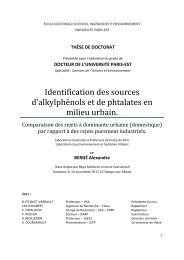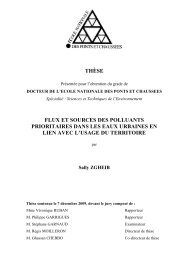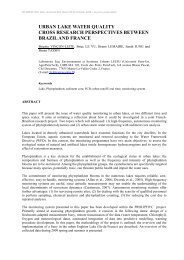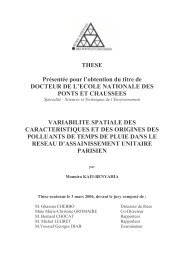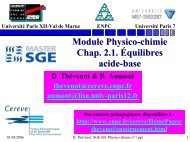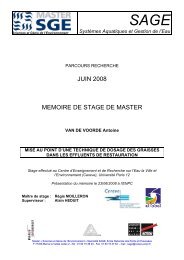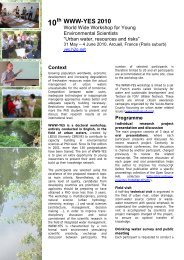07-WWW-YES-2010-Sonko - LEESU
07-WWW-YES-2010-Sonko - LEESU
07-WWW-YES-2010-Sonko - LEESU
Create successful ePaper yourself
Turn your PDF publications into a flip-book with our unique Google optimized e-Paper software.
<strong>WWW</strong>-<strong>YES</strong> <strong>2010</strong> France<br />
10th World Wide Workshop for Young Environmental Scientists<br />
Urban waters: resource or risks? Arcueil, France (31 May-4 June <strong>2010</strong><br />
Humification performance and<br />
helminth eggs inactivation in<br />
feacal sludge dewatering bed<br />
PhD Student: El hadji Mamadou <strong>Sonko</strong> (MSc.)<br />
ElhadjiMamadou.<strong>Sonko</strong>@eawag.ch<br />
PhD commitee:<br />
Dr Doulaye Koné (Eawag/Sandec)<br />
Dr Mbaye Mbéguéré (Eawag/Sandec – ONAS)<br />
Dr Seydou Nourou Sall (IRD)<br />
Prof. Bienvenu Sambou (ISE/UCAD)<br />
1
Context : Sanitation infrastructure in<br />
developing countries<br />
Latin America<br />
•<br />
•<br />
Tanzania<br />
Ghana<br />
Philippines<br />
Yaoundé<br />
Bangkok<br />
Percent of population served by<br />
on-site sanitation<br />
0 20 40 60 80 100<br />
Strauss et al, 1997, modified<br />
Most mega and capital cities are also latrine-based!<br />
2.6 billion urban dwellers use on-site sanitation<br />
(globally)!<br />
2
Consequences of MDGs in Sanitation<br />
With the increase of on-site sanitation in Dakar, the quantities of<br />
sludge produced, estimated at 1,350 m3/day in 20<strong>07</strong>, will increase<br />
significantly if the MDGs are achieved<br />
3
Faecal sludge management<br />
Manual Emptying Mechanichal Emptying<br />
4
Where the problem is...<br />
Anarchic discharge of faecal<br />
sludge collected into<br />
environment and use in<br />
agriculture<br />
consequences<br />
�Ecological (eutrophication , …)<br />
�Sanitary (diarrhoia and other diseases )<br />
�Economic (health costs, cleanup costs )<br />
5
However, excreta are<br />
resources !<br />
Nutrient<br />
N Nitrogen<br />
P Phosphorus<br />
Nutrient (kg)<br />
urine faeces Total<br />
500 l/an 50 l/an<br />
Required<br />
for 250 g<br />
of Cereals<br />
4.0 0.5 4.5 5.6<br />
0.4 0.2 0.6 0.7<br />
K Potassium 0.9 0.3 1.2 1.2<br />
6
Challenges 1<br />
How to produce safe biosolids<br />
from faecal treatment units that<br />
sustain agricultural productivity?<br />
7
Challenges 2 :<br />
How to control the cycles of<br />
C,N, P, K?<br />
Nothing lost,<br />
nothing is created,<br />
everything is<br />
transformed<br />
8
Objectives<br />
General objective:<br />
This thesis aims to first follow the purification performances but<br />
also to explain the mechanisms responsible for the<br />
humification and helminth eggs inactivation in biosolids<br />
Specific objectives:<br />
� SO1: follow the purification performance during the different<br />
experiments;<br />
� SO2: monitor the influence of residual moisture on the process of<br />
humification;<br />
� SO3: follow the influence of plant type on the process of humification;<br />
� SO4: follow the influence of the type of sludge on the process of<br />
humification;<br />
� SO5: follow the inactivation of helminth eggs in the different<br />
experiments during the maturation phase.<br />
9
Problem:<br />
Experimental disign 1: Yard-scale planted<br />
dewatering beds (Objective 1)<br />
Surface : 4 m2 (2x2)<br />
Depth : 85 cm<br />
Difficulties to control the flow<br />
Difficulty to do statistical analysis<br />
10
Methodologie: Pilot-scale<br />
planted dewatering beds<br />
� Same disign like yard-scale<br />
plants<br />
� Avantages<br />
- Control the inflows and outflows<br />
- Allowing repetition of<br />
experiments<br />
to answer statistical<br />
requirements<br />
1 2 3 2 3 1 3 1 2<br />
1: 200 Kg/m2/year, One application per week<br />
2: 200 Kg/m2/year,Two applications / week<br />
11<br />
3: 200 Kg/m2/year, Three applications per week
Methodology: Implementation<br />
of experimental units<br />
Four steps<br />
� Plantation (9 cuttings / m2)<br />
� Plants acclimatization (1-2 months)<br />
� Scalability : 25, 50, 75, 100, 150, 200 Kg TS/m 2 /year (2 months)<br />
� Operation at rated load 200 Kg TS/m2/an (6 Months)<br />
� Maturation period (3 months)<br />
Sludge loading rate (l)<br />
C1<br />
= ×<br />
C2<br />
With C1 = annual load = 200 kg MS/m2/an<br />
C2 = average concentration of sludge delivered by trucks emptying<br />
1<br />
52<br />
12
Methodology: Parameters for<br />
evaluating the quality of humus<br />
� Chemical criteria: C / N ratio, cation exchange capacity (CEC), NO3-,<br />
NO2 -, report NO3-/NH4 +, pH, ORP, conductivity, loss of ignition,<br />
analysis of substances easily biodegradable (sugars, amino acids,<br />
phenols, etc..) and readily biodegradable substances (fiber, lignin,<br />
tannins, etc..)<br />
� Microbiological and enzymatic criteria: measurement of biomass and<br />
diversity, latent metabolism evaluated by the rate of respiration,<br />
measurement of enzyme activity<br />
� Germination test: evaluation of phytoxicity residual (rate of seed<br />
germination, root length) Lepidium sativum L. or other test plants.<br />
� Analytical and spectroscopic criteria: quantity of humic or fulvic acids,<br />
humification indices (humification index, humification rate, rate of<br />
polymerization), spectroscopy: visible (E4/E6 ratio, infrared and UV)<br />
� Helminth eggs<br />
13
Parameter<br />
Results 1: Characteristics of<br />
raw sluge<br />
TS<br />
(mg/l)<br />
TSS<br />
(mg/g)<br />
COD<br />
(mg/l)<br />
TKN<br />
(mg/l)<br />
1 Kengne et al, 20092 Strauss, 2006<br />
NH4+<br />
(mg/l)<br />
NO3-<br />
(mg/l)<br />
TP<br />
(mg/l) pH<br />
Sal<br />
(g/l)<br />
Cond<br />
(ms/cm<br />
)<br />
Average 4109 3187 68<strong>07</strong> 325 352.8 2.84 79.8 7.6 1.88 4.06 -163<br />
Max 6264 5544 8456 626 845 5.7 119 7.8 3.5 6.82 -45<br />
Min 2932 1200 4546 318 141 0.6 32 7.3 1.1 2.77 -295<br />
Cameroon1 33400 33400 29900 1200 600 7.6 3 -59<br />
Accra (Ghana)2 12000 7800 330<br />
Ouagadougou<br />
(Burkina Fasso)2 19000 13500<br />
Bangkok<br />
(Tailand)2 15350 15700 415<br />
Faecal Sludge from Dakar are less concentrated (TS), then<br />
volumes to be treated with the same charge, will be higher<br />
14<br />
Eh<br />
(mV)
Results 2: Acclimatization phase<br />
Beginning<br />
After 6 weeks<br />
After 2 weeks<br />
After 4 weeks<br />
15
Purification Performances<br />
Purufication performances<br />
(%)<br />
100<br />
90<br />
80<br />
70<br />
60<br />
50<br />
40<br />
30<br />
20<br />
10<br />
0<br />
TS TSS COD TN TP Ammonia<br />
Parameters<br />
TS: Total Solid, TSS: Total Suspended Solid, COD: Chemical<br />
Oxygen Demand, TN: Total Nitrogen, TP: Total Phosphorus Good turbidity removal (TS, TSS)<br />
Despite these high rates of purification, leachate contain loads above<br />
Senegalese discharges standards into receiving environments or WHO<br />
standards for agricultural reuse.<br />
16
Biosolids Characteristics<br />
• Elemental composition (% Dry Matter)<br />
Nitrogen Carbon C/N Hydrogen Sulphur<br />
DS 1st week 1.93 23.38 12.11 3.50 0.24<br />
DS 2nd week 2.88 31.98 11.10 5.11 0.28<br />
DS 5th week 2.93 32.40 11.05 0.84 0.34<br />
DS 7th week 2.92 31.99 10.95 3.00 0.33<br />
Biosolids 1 2 22.6 11.3<br />
1 : Kengne et al, 2008<br />
Biosolids have the same characteristics as those that had a maturity period of<br />
6 months (Kengne et al, 2008).<br />
Hypothèse: Faecal sludge from which they are derived, may have to start their<br />
conversion into septic tanks where they accumulate for at least six months.<br />
17
Biosolids Characteristics<br />
• Chemical composition of sludge (% DM)<br />
DS 1st week 0.17 1.4<br />
DS 2 nd week 0.21 1.36<br />
DS 5th week 0.24 1.34<br />
DS 7th week 0.19 1.41<br />
Na2O MgO SiO2 P2O5 S K2O CaO<br />
27.6<br />
4 4.24 2.17 1.03<br />
11.2<br />
8<br />
14.5<br />
3 4.<strong>07</strong> 2.01 0.74 8.33<br />
16.6<br />
8 4.13 2.12 0.75 9.08<br />
15.7<br />
7 4.34 2.08 0.73 9.08<br />
Biosolids 1 0.09 0.14 - 2.3 - 0.03 1.04<br />
Converted Sludge 2 - 0.8 - 0.6 - 0.4 -<br />
1 Kengne et al, 2008 (Cameroon) 2 GTZ, 2005 (Egypt)<br />
The chemical composition of these parameters in biosolids depends<br />
essentially on nature of raw sludge.<br />
18
Biosolids Characteristics<br />
• Heavy metals content (mg/Kg TS)<br />
TiO2 Cr Pb Rb Zn Co Ni Cu<br />
DS 1st week 276 9.3 9.8 3.1 103 3.8 1.9 29.8<br />
DS 2nd week 239 8.4 12.7 2.7 1<strong>07</strong> 1.8 1.7 28.8<br />
DS 5th week 258 7.3 10.7 2.7 123 1.5 2.4 32<br />
DS 7th week 264 9.4 10.9 2.6 129 2.9 2.4 33.2<br />
EC eco label<br />
compst 1 100 100 50 50 100<br />
DS: Dry solid 1 : Hogg et al, 2002<br />
The concentration of heavy metals in biosolids is<br />
below than limits seted by EC eco label compost<br />
19
Expected results<br />
� Good knowledge of supply frequency, plants choice and<br />
the method of sludge pre-treatment that allow an efficient<br />
purification<br />
� Determining the best supply frequency for sludge<br />
dehydration and mineralization<br />
� Selection of the appropriate plant or plant association for<br />
proper sludge drying and mineralization<br />
� Selection of the best quality of sludge, which offers a<br />
better quality of humus<br />
� Determination of time required to inactivate helminth eggs<br />
� Development of design criteria of planted drying beds in<br />
sub-Saharan Africa<br />
20
Thank you !<br />
El hadji Mamadou <strong>Sonko</strong> (MSc.)<br />
ElhadjiMamadou.<strong>Sonko</strong>@eawag.ch<br />
ED-SEV/UCAD<br />
www.ucad.sn<br />
Eawag/Sandec – Switzerland<br />
www.sandec.ch<br />
Tel.+41 (0)44 823 55 53<br />
21


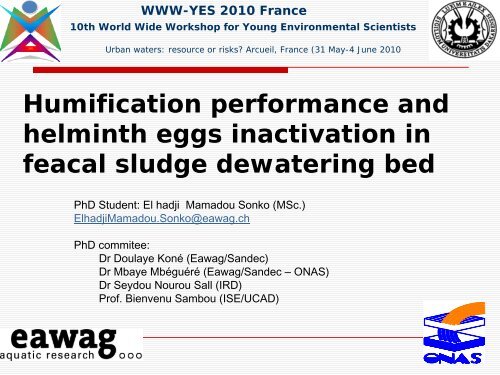

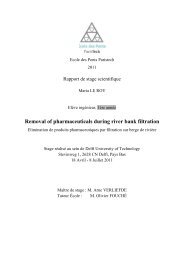
![[pastel-00730831, v1] Incidence des pratiques d'entretien ... - LEESU](https://img.yumpu.com/50938896/1/184x260/pastel-00730831-v1-incidence-des-pratiques-dentretien-leesu.jpg?quality=85)

